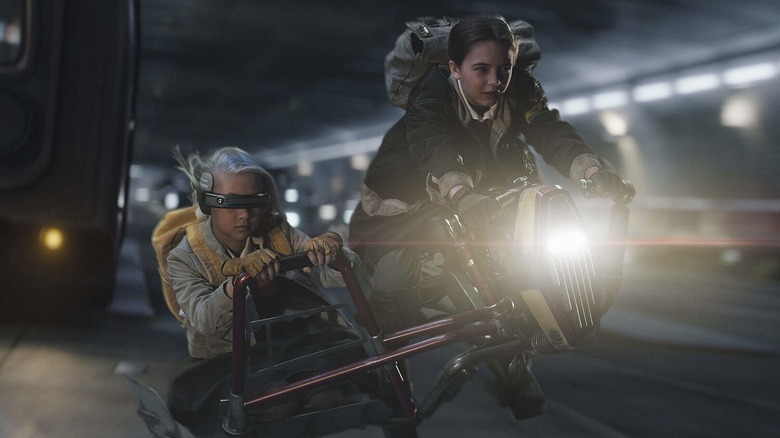Skeleton Crew Takes Cues From A Pre-Star Wars George Lucas Movie
Spoilers ahead for the first episode of "Star Wars: Skeleton Crew."
"Star Wars" is known for a lot of things. Lightsabers. Swashbuckling action. Tyrannical villains. Daring escapes. True love. Soul-searing music. Special effects extravaganzas. Incredible filmmaking. Within certain parameters, you know exactly what you're getting into with a live action "Star Wars" project.
Sure, that pendulum can swing pretty hard. On one side, you can get pretty gritty and realistic stories — "Andor," for instance — and on the other side you can get much more innocent, swashbuckling, kid-oriented adventures like "Skeleton Crew." But one thing that unites all of the "Star Wars" projects is the inspiration from other films that filmmakers pour into their work. Sometimes, those films can be from their own interests, like Rian Johnson bringing his love of "Brazil" into his masterpiece "The Last Jedi," and other times it can be filmmakers bringing George Lucas's foundational reliance on the work of Akira Kurosawa into "Star Wars." For instance, J.J. Abrams cited "High and Low" as an influence on "The Force Awakens" and "Rashomon" was cited by Leslye Headland for "The Acolyte" and again by Rian Johnson for "The Last Jedi."
George Lucas often went back to his own pre-"Star Wars" films, and it's always great to see other filmmakers do so as well, like we see in these opening episodes of "Skeleton Crew".
American Graffiti and George Lucas's need for speed
"American Graffiti" was George Lucas's second major film, and his first box office hit. It tells the tale of a bunch of rebellious teenagers on one last night after their high-school graduation before they split up before heading in different directions: some to college, some to adulthood, some resigned to oblivion. It's about racing and dating cultures, it's about the '50s, it's about a lost time in the romance of Americana. Above all, it's a terrific film. Starring Ron Howard, Cindy Williams, Paul LeMat, Mackenzie Phillips, Richard Dreyfuss, Charlie Martin Smith, and Harrison Ford among others, "American Graffiti" is a stunning snapshot of a moment from Lucas's youth that no longer exists in America, and it exemplifies his incredible filmmaking — and doubles down on his obsession with capturing speed on film, which began with his debut feature, "THX 1138."
"Star Wars" films have long been a test bed for George Lucas and other filmmakers to play with this goal of capturing dangerous speeds on film. In "A New Hope" George Lucas outdid himself with the trench run. In "The Empire Strikes Back," we bore witness to snowspeeders racing through the legs of Imperial Walkers. "Return of the Jedi" turned everything up to 11, both on the ground with the speeder bikes on Endor, and in space with Rebel fighters flying into the Death Star's super structure and back out again. In "Star Wars: The Phantom Menace," Lucas managed to do it again with the podrace.
All of these build on the foundation of the racing from "American Graffiti", and Jon Watts and crew managed to take that a step further with their wholesome suburban Americana of "Skeleton Crew." Combining the high speed racing of "American Graffiti" with the kids-on-bikes charm of '80s Spielberg movies, "Skeleton Crew" gives us a version of the high-stakes speeder action from "Return of the Jedi," but with the kids simply racing for fun and getting into danger. And if that wasn't enough, it also gives us a direct reference to "American Graffiti."
Bhonjj Falfa is a nod to Harrison Ford's character in American Graffiti
When Fern and KB are trying to fix Fern's speeder, a kid rolls by on a speeder of his own. He looks suspiciously like a young Ben Solo (though we know it's not him) and asks if she's going to race him. KB identifies him as Bhonj Falfa.
This is a multi-layered reference to Harrison Ford's characters in both "Star Wars" and "American Graffiti." The kid resembling Ben Solo is a tip of the hat to his Han Solo character, but the name and situation is a nod to "American Graffiti." In "American Graffiti," Ford played a cowboy-hat-wearing racer named Bob Falfa, who spent the film seeking out John Milner (Paul LeMat) and his car (which was a color he described as a mix somewhere between "piss-yellow and puke-green," with a license plate reading THX-138 no less) so they could race. The climax of the film was that race.
This isn't the first time "American Graffiti" has inspired similar storylines. Flea's character Needles in the last two installments of "Back to the Future" was inspired by Bob Falfa as well, and the race played into Marty's story at the end, just like it did John Milner's. It makes one wonder if racing Bhonj Falfa will figure into Fern's story by the end of her journey. That is, of course, if she ever makes it back home to At Attin.
New episodes of "Skeleton Crew" air on Tuesday nights on Disney+.


